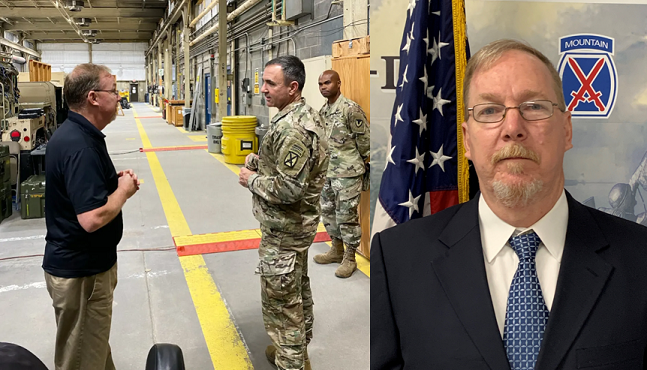 Mr. James Duxbury
Mr. James Duxbury
In the left photo, he briefs MG Gregory Anderson, CDR 10th MTN DIV
MSG Half-Mast recently traveled to Ft Drum to visit with Mr. James Duxbury, the AMC C5ISR Lead-System Tech Rep (L-STR) for the 10th Mountain Division/CECOM Integrated Logistics Support Center (ILSE) Forward Element – East Region, Army Field Support Battalion-Drum, 406th AFSB. They discussed the role of the L-STR in helping to improve C5ISR readiness.
Mr. Duxbury was born in Pittsburgh, PA. He enlisted in the U.S. Army in 1983 as a multichannel communications operator, later becoming a switchboard team chief and then, after reclassifying, a network switching system team chief. He held positions as senior operator, section sergeant, platoon sergeant and 1SG. After completing a 3-year tour with Recruiting Command, he was assigned as the NCOIC of the Communications-Electronics Command (CECOM) Telemaintenance Program at Ft. Monmouth, NJ, until retirement. Post-active duty, he served as a defense contractor before entering civil service as a logistics assistance representative (LAR) and serving as the telemaintenance project lead. He later became the C5ISR lead-system tech representative (L-STR) with the AFSBn at Ft Drum, where he currently serves, overseeing a nine-state region in the Northeast, as well as Ft Polk, LA. He is responsible for integrating forward sustainment maintenance and providing logistics support for all Army C5ISR equipment through a tailored network of both organic and contracted service providers. He has also served as a C5ISR lead in Afghanistan, Iraq and Kuwait.
MSG Half-Mast: I’ve heard the term “trail bosses” bandied about in the field. Can you explain what a trail boss is and does?
Mr. Duxbury: First, the term “trail boss” is no longer used. Instead, at CECOM, we now refer to them as AMC Command, Control, Computers, Communications, Cyber, Intelligence, Surveillance and Reconnaissance (C5ISR) Lead-System Tech Representatives (L-STRs). L-STRs are Department of the Army civilian experts who assist the field, whether Active Army, National Guard or Reserves.
MSG Half-Mast: How do CECOM L-STRs interface with supported units?
Mr. Duxbury: L-STRs work at the corps or division (DIV) level and below. They directly support their assigned Army Field Support Battalion (AFSBn) commander and coordinate with the AFSBn’s support operations (SPO) directorate to prioritize C5ISR support resources within the commander's intent.
Hierarchy includes L-STRs
Among their duties, L-STRs typically attend division-level meetings, address CECOM-specific policy and procedures and keep track of the division’s operations to determine current and future needs. They continuously work closely with division and brigade combat team (BCT) staffs (2/3/4/6/8) to resolve their commander’s technical and/or logistics concerns affecting their supply, readiness and training ratings.
The L-STRS also analyze trends based off the equipment status report (ESR), inputs into logistics assistance representative (LAR)-Visibility (LARVIS) system and data emerging from combat training center (CTC) rotations. Data collected in LARVIS are shared with supported units to improve future Soldier training and maintenance programs. The information is also provided to maintenance and supply chain managers in the CECOM Integrated Logistics Support Center to better posture resources to support B16 source of supply equipment.
MSG Half-Mast: What role, if any, does the L-STR have in unit training?
Mr. Duxbury: Working with the relevant Program Executive Office and the Division G3 and BDE S3 force integration officers, L-STRS can assist with any new equipment training and new equipment fielding (NET/NEF). They guide and assign the LARs and field service representatives (FSRs) to provide support for systems in CECOM sustainment and help fill training gaps with over-the-shoulder training on their C5ISR systems. A lot of this training is done at the unit motor pool on the unit’s own equipment.
MSH Half-Mast: How do L-STRs differ from LARs?
Mr. Duxbury: L-STRs and LARs both provide expert technical advice, assistance and instruction at different levels in the hierarchy. L-STRs have a broader understanding of the programs that support all C5ISR systems, not just one. The L-STRs also supervise the LARs.
Editor's Note: To learn more about LARs, see our article
HERE.
For a regional POC list of CECOM L-STRS, visit our milSuite repository
HERE (CAC required).